It's so pretty!First membrane with the 360 mm wide tape (the paper under it is of A3 size):
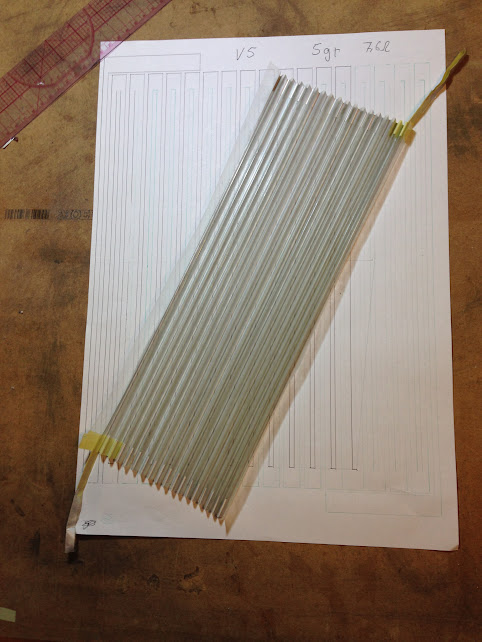
Now isn't that a beauty!
/Anton
Some measurements of version 5 (V5) of the membrane.
First out is V5 (blue) vs V4 with a dampening box behind, 2nd HD and 3rd HD:

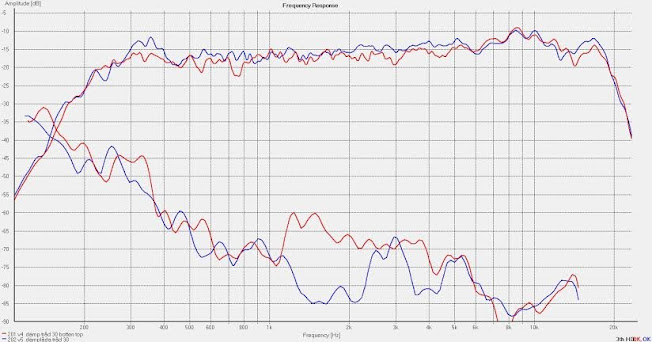
Note that V5 is in the second motor (202) so there could be other differences as well.
Clearly lower distortion level in V5 but there´s still some action around 3 and 5 kHz. Still on the level as for V4 though.
The only thing that is worse in the 2nd HD at 5 kHz.
Only V5 with box and wave guide measurer at 30 cm, 1 m and 1,5 m. 3rd HD shown.

At 1 and 1,5 m, the room influences a lot.
V5 with box at 10, 20 and 30 cm. 2nd HD and 3rd HD:


So with two AMT Mk II with acceptable measurement results, I finally sat down and listened to music through them.
Just popped out the old AMTs with wave guides and put the new test rigs ones in front of the baffle.
So far still Q&D wave guides. Excuse me for the poor iPhone quality at poor light.
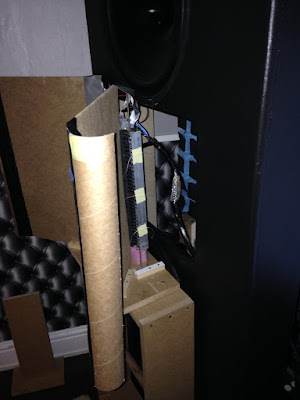
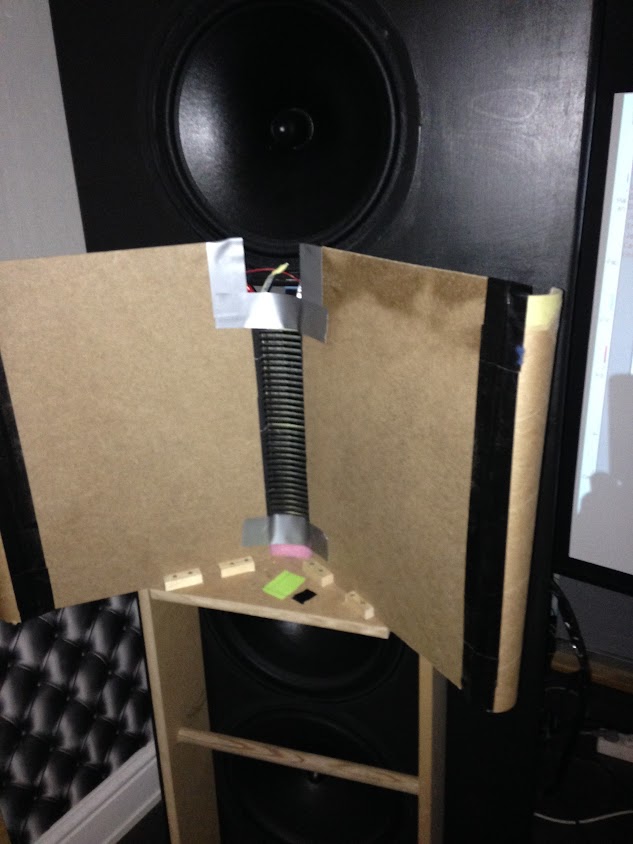

I have now listened for an hour or so and the new membrane shave faster attack and better resolutions in the highs.
You can see here what I was (or are) listening to.
V5 is definitely better than V4, so I must make another V5 ASAP.
I have seven cotton threads to tie the brass rods to the magnets in V5 but also 1 mm silicon rubber sheet in between.
First out is V5 (blue) vs V4 with a dampening box behind, 2nd HD and 3rd HD:
Note that V5 is in the second motor (202) so there could be other differences as well.
Clearly lower distortion level in V5 but there´s still some action around 3 and 5 kHz. Still on the level as for V4 though.
The only thing that is worse in the 2nd HD at 5 kHz.
Only V5 with box and wave guide measurer at 30 cm, 1 m and 1,5 m. 3rd HD shown.
At 1 and 1,5 m, the room influences a lot.
V5 with box at 10, 20 and 30 cm. 2nd HD and 3rd HD:
So with two AMT Mk II with acceptable measurement results, I finally sat down and listened to music through them.
Just popped out the old AMTs with wave guides and put the new test rigs ones in front of the baffle.
So far still Q&D wave guides. Excuse me for the poor iPhone quality at poor light.
I have now listened for an hour or so and the new membrane shave faster attack and better resolutions in the highs.
You can see here what I was (or are) listening to.
V5 is definitely better than V4, so I must make another V5 ASAP.
I have seven cotton threads to tie the brass rods to the magnets in V5 but also 1 mm silicon rubber sheet in between.
While I wait for the inspiration to make the wave guides for Mk II, and in order to have something to listen to, I mounted the V5 membrane into Mk I.
The magnetic flux density is less in Mk I, but on the other hand are the back pole pieces loose so that I can experiment with the mitigation of the reflections.
Comparison with the Mk I old two part membranes and the new V5 (red). Only 1/3 octave smoothing, sorry:

Comparison Mk II with primitive dampening box behind and a Q&D wave guide in front with Mk I (red), 1/24 octaves smoothing:

Comparison Mk I with V5 membrane, 1 W (red and offseted 10 dB) with 10 W. N sign of compression in LF:

Measuring at 1 m means that the room contributes a lot, so here's a comparison between 1 W (red) and 10 W at 50 cm distance.
3rd harmonic distortion shown:
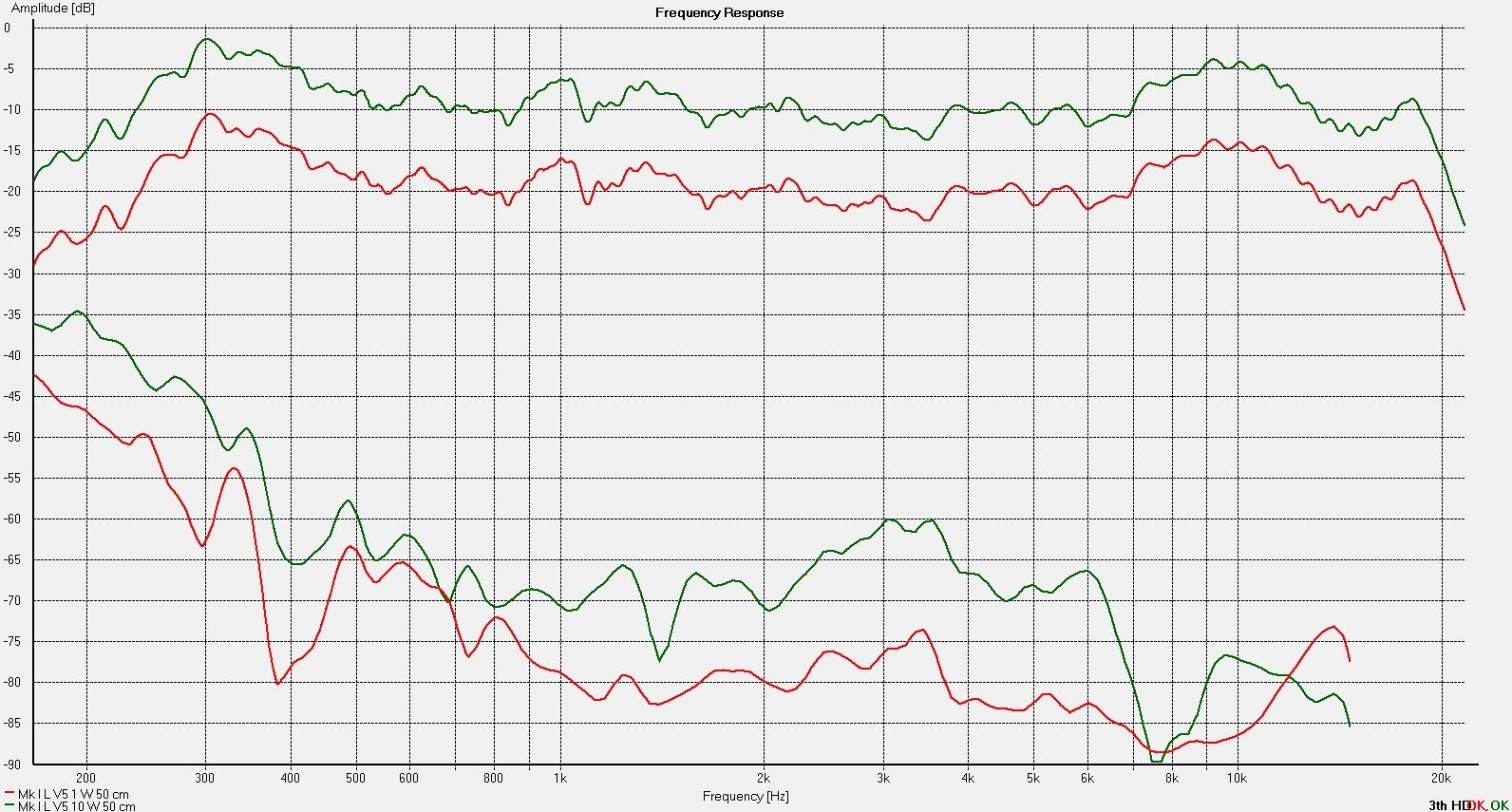
The magnetic flux density is less in Mk I, but on the other hand are the back pole pieces loose so that I can experiment with the mitigation of the reflections.
Comparison with the Mk I old two part membranes and the new V5 (red). Only 1/3 octave smoothing, sorry:
Comparison Mk II with primitive dampening box behind and a Q&D wave guide in front with Mk I (red), 1/24 octaves smoothing:
Comparison Mk I with V5 membrane, 1 W (red and offseted 10 dB) with 10 W. N sign of compression in LF:
Measuring at 1 m means that the room contributes a lot, so here's a comparison between 1 W (red) and 10 W at 50 cm distance.
3rd harmonic distortion shown:
What the measurements actually shows is that despite the new Mk II, the only upside so far is 8 dB increase in SPL.
I reckon the Mk II will perform better with a well designed wave guide, now it is a little bit jumpy in the LF (green):

The real improvement is in the membrane. The new "suspension" and layout with the 360 mm tape is what really has done the trick.
So was it worth $170 ($250 - $80) extra per AMT and a lot of work to only gain 8 dB?
Development wise yes as it drove the membrane layout and suspension improvements.
Product wise wise no, 100 dBm @ 1 m/1 W is good enough for any element.
I reckon the Mk II will perform better with a well designed wave guide, now it is a little bit jumpy in the LF (green):
The real improvement is in the membrane. The new "suspension" and layout with the 360 mm tape is what really has done the trick.
So was it worth $170 ($250 - $80) extra per AMT and a lot of work to only gain 8 dB?
Development wise yes as it drove the membrane layout and suspension improvements.
Product wise wise no, 100 dBm @ 1 m/1 W is good enough for any element.
I agree completely, a sensitivity above 100 dB even sets higher requirements on electronics and cables to reduce noise.What the measurements actually shows is that despite the new Mk II, the only upside so far is 8 dB increase in SPL.
I reckon the Mk II will perform better with a well designed wave guide, now it is a little bit jumpy in the LF (green):

The real improvement is in the membrane. The new "suspension" and layout with the 360 mm tape is what really has done the trick.
So was it worth $170 ($250 - $80) extra per AMT and a lot of work to only gain 8 dB?
Development wise yes as it drove the membrane layout and suspension improvements.
Product wise wise no, 100 dBm @ 1 m/1 W is good enough for any element.
/Anton
Well , i think THE extra spl is à bonus to be honest.
With such high spl you could think of verry small amps with low gain and verry high self noise. I won't reckon a 1000 w amp an then use only 0,3 watt effective. The power amp still has this high gain an thus. Wich induces noise.
Ah well I think it's luxury to be able to chose any amp you want, and always have. Enough power
With such high spl you could think of verry small amps with low gain and verry high self noise. I won't reckon a 1000 w amp an then use only 0,3 watt effective. The power amp still has this high gain an thus. Wich induces noise.
Ah well I think it's luxury to be able to chose any amp you want, and always have. Enough power
Absolutely! You just have to use short interconnects or balanced amps. Probably not a problem as the budget should be pretty high with this kind of speakers. I just thought that most people here own amps that work well for tweeters with sensitivity between 90 and 100 dB.Well , i think THE extra spl is à bonus to be honest.
With such high spl you could think of verry small amps with low gain and verry high self noise. I won't reckon a 1000 w amp an then use only 0,3 watt effective. The power amp still has this high gain an thus. Wich induces noise.
Ah well I think it's luxury to be able to chose any amp you want, and always have. Enough power
/Anton
One can also state that an AMT motor with custom made pole pieces and a massive amount of magnets isn't necessary.
It is enough with simple OTS 5x5 iron rods cut as pole pieces.
Anyway, the story continues:
Stay tuned.
It is enough with simple OTS 5x5 iron rods cut as pole pieces.
Anyway, the story continues:
- What about the 9-10 kHz reflection?
- What about a better wave guide?
- What about the modulation in the paper's plane?
Stay tuned.
Look, no back
So what about the 9-10 kHz reflections?
Made a comparison with and without the back pole pieces on a Mk I.
The pole pieces on the Mk I is very simple, just 5x5 mm iron rods.
First some FEMM simulations.
With back pole pieces:

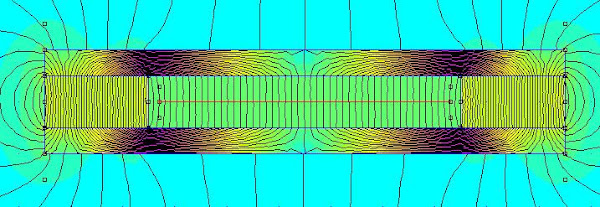
Magnetic normal flux density ( = desired flux) and tangential flux (shall be as little as possible) respectively:


Without back pole pieces:


Magnetic normal flux density ( = desired flux) and tangential flux (shall be as little as possible) respectively:
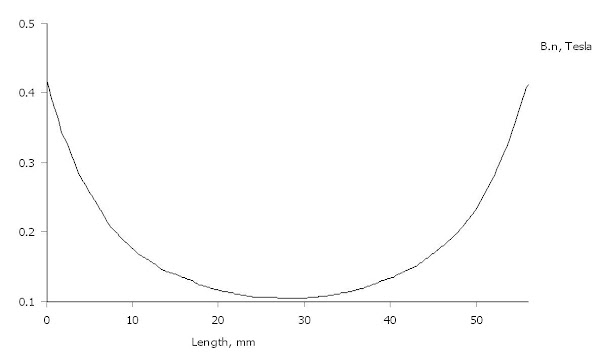
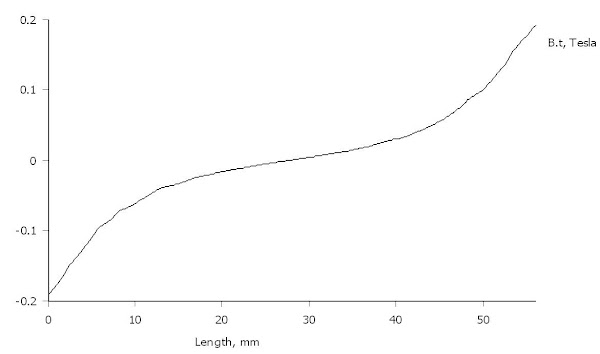
As expected does this geometry give some crazy flux lines, will probably neither measure nor sound well.
So what about the 9-10 kHz reflections?
Made a comparison with and without the back pole pieces on a Mk I.
The pole pieces on the Mk I is very simple, just 5x5 mm iron rods.
First some FEMM simulations.
With back pole pieces:
Magnetic normal flux density ( = desired flux) and tangential flux (shall be as little as possible) respectively:
Without back pole pieces:
Magnetic normal flux density ( = desired flux) and tangential flux (shall be as little as possible) respectively:
As expected does this geometry give some crazy flux lines, will probably neither measure nor sound well.
Some measurements then. 1 W at 50 cm in order to not get that much of the room. Blue is without pole pieces.
Smoothing 1/24 octave:

Smoothing 1/12 octave:
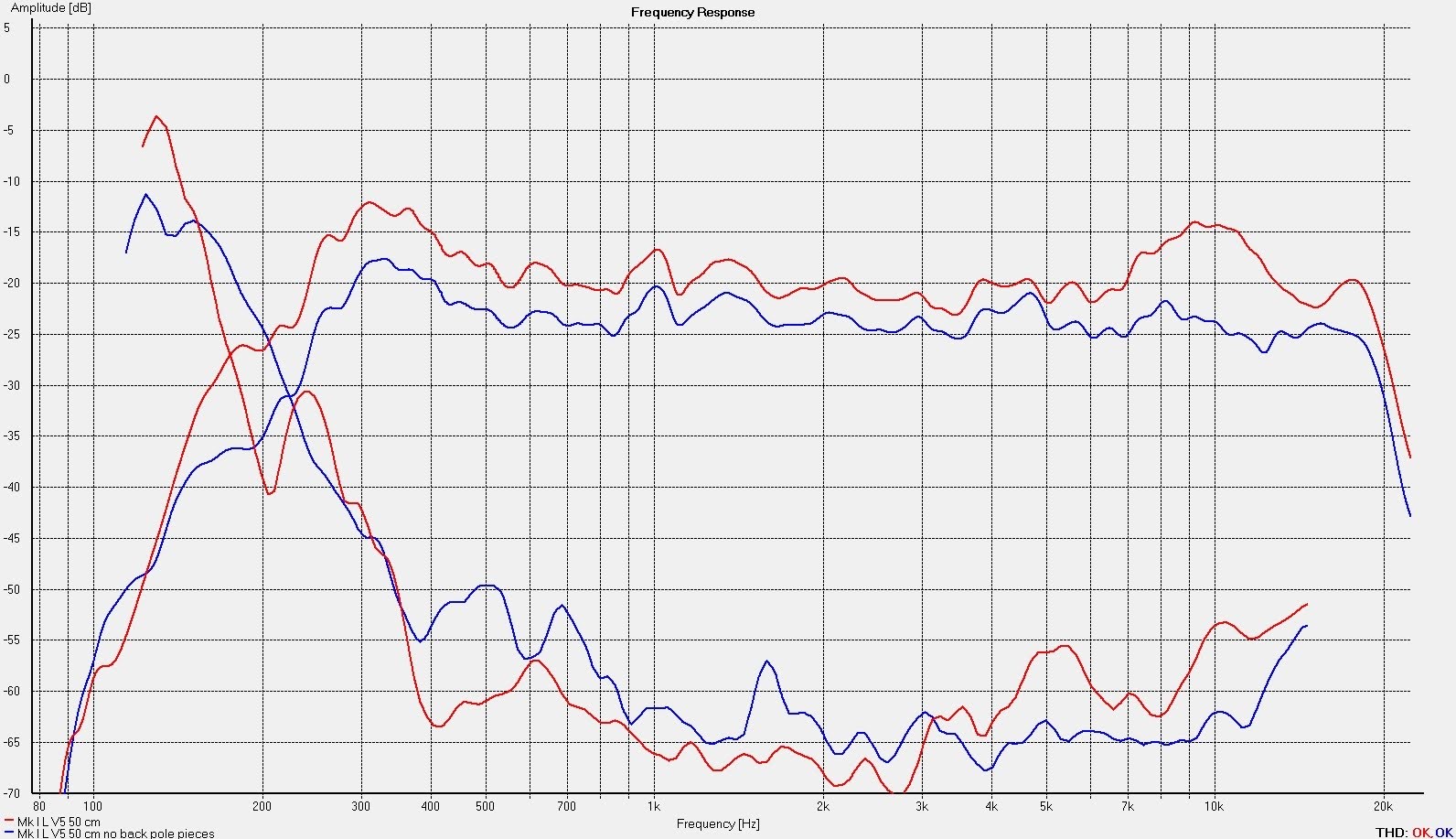
Smoothing 1/3 octave:
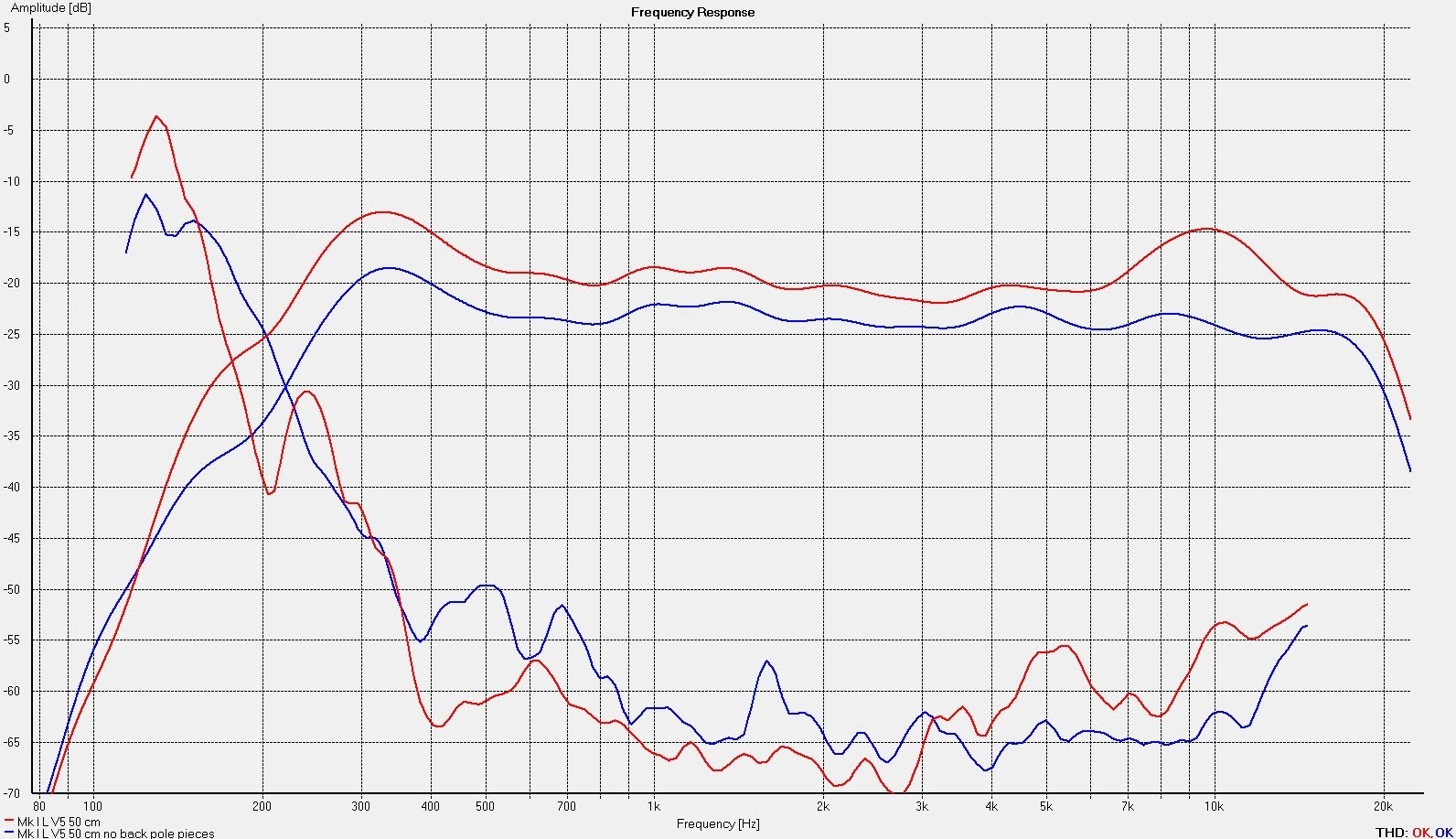
A little more distortion in LF due to the non-linear magnetic flux density. It looks bad around 500 Hz (2HD, 3HD), 700 Hz (2HD) and 1500 Hz (3HD).
The fact that flux density is less in the middle of the gap could be good; the membrane´s non-desired movement to and fro would be less.
So if the flux density can be more "normal" at the beginning and end of the gap, this could be a way forward.
The 9-10 kHz reflection?
Well, it disappeared. But we kind of knew that already, didn´t we ?
?
I am a little bit surprised though that the SPL only were 4-5 dBs less.
Smoothing 1/24 octave:
Smoothing 1/12 octave:
Smoothing 1/3 octave:
A little more distortion in LF due to the non-linear magnetic flux density. It looks bad around 500 Hz (2HD, 3HD), 700 Hz (2HD) and 1500 Hz (3HD).
The fact that flux density is less in the middle of the gap could be good; the membrane´s non-desired movement to and fro would be less.
So if the flux density can be more "normal" at the beginning and end of the gap, this could be a way forward.
The 9-10 kHz reflection?
Well, it disappeared. But we kind of knew that already, didn´t we
I am a little bit surprised though that the SPL only were 4-5 dBs less.
Last edited:
I think that I have to make some kind of pole pieces in the back anyway.
One way is to have two 1,5 mm thick and 10 mm high pole pieces for every front pole piece.
Maybe even sharpen them where they meet the back wave in a stealth kind of way; to reduce the "target area" so to speak.
I have now listened to Mk I without the back pole pieces, without the 9 kHz EQ of course but also without adjusting the overall lower SPL.
Something definitely happen, especially female jazz vocalist changed; they all sound more clear.
This is not only due to the lower HF. In fact, I think that was a good side effect; almost every visitor I have had has complained about the "sharpness" of the speakers.
I'll keep it like this for awhile and then lower the bass a couple of the dBs in order to get a sanity check.
The removed reflection not only removed the 9-10 kHz "hump" but now all direct front sound are not inter-modulated with the 0,05 ms delayed reflection.
It shouldn't be audible, but perhaps there were cascading effects and audible inter-modulation that now are gone.
A penny* for your thoughts!
* or whatever is you local currency's least valuable coin/bill .
.
One way is to have two 1,5 mm thick and 10 mm high pole pieces for every front pole piece.
Maybe even sharpen them where they meet the back wave in a stealth kind of way; to reduce the "target area" so to speak.
I have now listened to Mk I without the back pole pieces, without the 9 kHz EQ of course but also without adjusting the overall lower SPL.
Something definitely happen, especially female jazz vocalist changed; they all sound more clear.
This is not only due to the lower HF. In fact, I think that was a good side effect; almost every visitor I have had has complained about the "sharpness" of the speakers.
I'll keep it like this for awhile and then lower the bass a couple of the dBs in order to get a sanity check.
The removed reflection not only removed the 9-10 kHz "hump" but now all direct front sound are not inter-modulated with the 0,05 ms delayed reflection.
It shouldn't be audible, but perhaps there were cascading effects and audible inter-modulation that now are gone.
A penny* for your thoughts!
* or whatever is you local currency's least valuable coin/bill
 .
.Very interesting experiment solhaga! Have you tried measuring with only the back pole pieces? Might be interesting to see if it is a standing wave phenomenon.I think that I have to make some kind of pole pieces in the back anyway.
One way is to have two 1,5 mm thick and 10 mm high pole pieces for every front pole piece.
Maybe even sharpen them where they meet the back wave in a stealth kind of way; to reduce the "target area" so to speak.
I have now listened to Mk I without the back pole pieces, without the 9 kHz EQ of course but also without adjusting the overall lower SPL.
Something definitely happen, especially female jazz vocalist changed; they all sound more clear.
This is not only due to the lower HF. In fact, I think that was a good side effect; almost every visitor I have had has complained about the "sharpness" of the speakers.
I'll keep it like this for awhile and then lower the bass a couple of the dBs in order to get a sanity check.
The removed reflection not only removed the 9-10 kHz "hump" but now all direct front sound are not inter-modulated with the 0,05 ms delayed reflection.
It shouldn't be audible, but perhaps there were cascading effects and audible inter-modulation that now are gone.
A penny* for your thoughts!
* or whatever is you local currency's least valuable coin/bill.
/Anton
Turned back
So here are comparitive measurements:
Red: Measured at front with pole pieces front and back. AMT in the baffle.
Blue: Measured at front with pole pieces front. AMT free.
Green: Measured at the back with pole pieces front. AMT free.
1 W 50 cm, 1/24 octave smoothing:

1 W 50 cm, 1/12 octave smoothing:

The two last measurement are done on a "free" AMT, so there may be more artifacts from the room. The interesting part is around 9-10 kHz anyway.
So the hump is still there when measuring from the back as expected but not as significant compared to having pole pieces both in the front and the back.
So perhaps there's a standing wave as well in the fully equipped AMT as onni suggested.
I see that there is a smaller hump between 4 and 5 kHz followed by a dip in the frontal measurement without the back pole pieces (blue).
When measured in the baffle it looked like this (from the previous post):

Perhaps this one is due the not so perfect wave guide throat.
So here are comparitive measurements:
Red: Measured at front with pole pieces front and back. AMT in the baffle.
Blue: Measured at front with pole pieces front. AMT free.
Green: Measured at the back with pole pieces front. AMT free.
1 W 50 cm, 1/24 octave smoothing:
1 W 50 cm, 1/12 octave smoothing:
The two last measurement are done on a "free" AMT, so there may be more artifacts from the room. The interesting part is around 9-10 kHz anyway.
So the hump is still there when measuring from the back as expected but not as significant compared to having pole pieces both in the front and the back.
So perhaps there's a standing wave as well in the fully equipped AMT as onni suggested.
I see that there is a smaller hump between 4 and 5 kHz followed by a dip in the frontal measurement without the back pole pieces (blue).
When measured in the baffle it looked like this (from the previous post):
Perhaps this one is due the not so perfect wave guide throat.
- Status
- This old topic is closed. If you want to reopen this topic, contact a moderator using the "Report Post" button.
- Home
- Loudspeakers
- Planars & Exotics
- Yet another DIY AMT